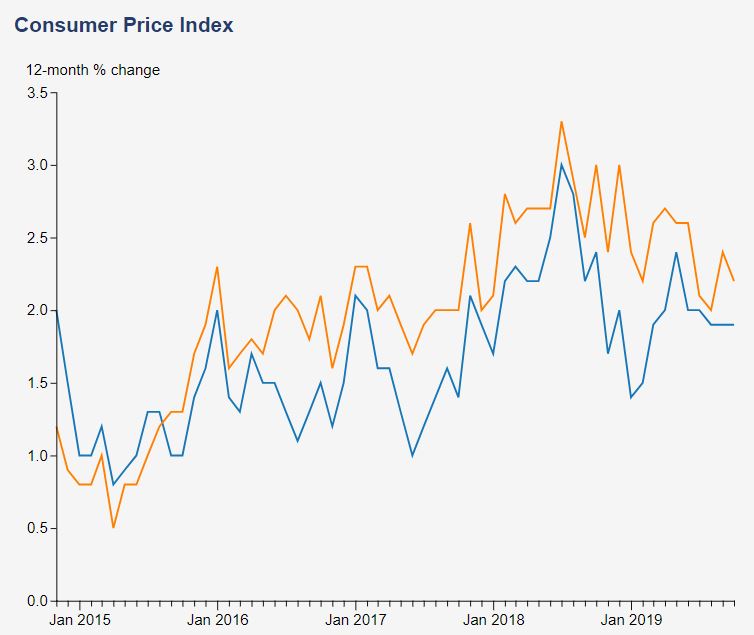
By Michael O’Neill
If you are an auto enthusiast, living in Vancouver, and want to know the answer to the Ford vs Ferrari question, drive to the Cineplex Odeon on West Pender. A ticket will set you back $12.50, before treats and after two and half hours, the question will be answered. The question not answered is why have movie ticket prices jumped 15.2% and gas prices risen 23%, since 2016. Statistics Canada claims inflation only rose 9.2% in the period.
Something is amiss.
Bank of Canada officials are suffering muscle strains from patting themselves on their backs, and telling Canadian’s that inflation is on target. Their monetary policy mandate is to preserve the value of money by keeping inflation low, stable, and predictable. They think they nailed it. Their inflation control target is 2% percent, the middle of their 1-3% target range.
Statistics Canada validated the BoC’s inflation achievement. On November 20 they said, “The Consumer Price Index (CPI) rose 1.9% on a year-over-year basis in October, matching the increase in August and in September.” They were especially pleased that “On a year-over-year basis, consumers paid 6.7% less for gasoline in October following a 10.0% decline in September.”
Really? If inflation is so low, why does it feel like everything costs more? A one bedroom condo in Vancouver, could be rented for $1900/month in 2017. The same unit rents for $2,200 as of November 13, 2019. That 15.7% increase is substantially higher than the 4.0% inflation rate for the same period. It’s a similar story for the Toronto area where condo rental prices have risen 21%. Ontario Hydro bills are 75% higher than they were in 2008. Self.com produces an iPhone Price index. The price top-of-the-line phone soared 121% since 2007. If you don’t have an iPhone, use electricity, or pay rent, you may buy what the BoC is selling.
Then there is the “stealth” inflation. The Ontario Health Insurance Plan stopped funding some services and procedures, increasing costs to patients. It is not called inflation, but you are out of pocket. Canada Post adds a “fuel surcharge” to the fee for sending a parcel. That’s not termed a price increase, but you still pay more for the service. Chocolate bars are shrinking in size as prices climb. Hundreds of other products have similar characteristics. Check out a bags of potato chips, or cookies. Bacon, formerly sold in 454 gram packages, is now sold in 375 gram packs. You pay more for less. Sporting events and concert tickets prices soared. Service providers are big on charging administration fees. Your local Bank has a myriad of “additional costs” for services that once were included with a Chequing and Savings account. Governments tax other taxes. (check out a gas pump price)
Canadian climate change initiatives are the sneakiest stealth inflation item of them all. The Canadian government says for most Canadian’s, carbon tax plans are “revenue neutral.” It would only be true if Canadian manufacturing, raw materials, and services industries decide not to pass their higher costs on to customers. That’s not likely. When the climate changes, consumers will be paying more for everything.
Chart: CPI change Nov/14 to October 19. Blue line= Canada; Orange line = Vancouver

“Vancouver CPI is higher than the National Average” Source: Stats Canada
“Stealth” inflation may be just one cost facing Canadians in the coming months. If China and the US come to terms on a trade agreement, Canada may suffer. President Trump is demanding China increase purchases of American agricultural products to the tune of $50 billion. The increase in US market share must come at the expense of another country, and Canada is the likely victim. China has already shown that it can ban Canadian agricultural exports and source those products elsewhere.
China is incensed at the Canadian government. They consider the arrest of Huawei CFO Meg Wanzhou, to satisfy a US extradition request, as meddling. China is Canada’s second-largest trading relationship, but Canada doesn’t even make it on the list of China’s Top 15 trading partner. Who needs who?
The Canadian Energy Research Institute (CERI) is very concerned. They fear a US/China trade deal could give the US energy sector preferential access to the Chinese market, which could make the American’s, China’s biggest supplier of Liquid Natural Gas (LNG). Canada is currently building an $18 Billion LNG plant in Kitimat, British Columbia and China is a logical customer.
The Bank of Canada is not concerned about rising inflation at all. In the October MPR, they said the “risks are tilted to the downside due to the adverse effects of announced tariffs and elevated uncertainty.” What happens if those risks go away?
American and Chinese officials repeatedly say a trade deal is close. A month ago, markets were salivating over the prospect of signing a Phase 1 deal in November. Today, not so much, but both sides are still talking. A deal will happen and when it does, worries about low inflation should evaporate. The leading global central banks continuously cited trade concerns to explain weak economic growth, and a lack of business investment. It stands to reason, that if the trade concerns disappear, it will spur business investment, boost economic growth, and raise demand for goods and services. Prices will definitely rise.
If that happens, will they continue to say inflation is low?





